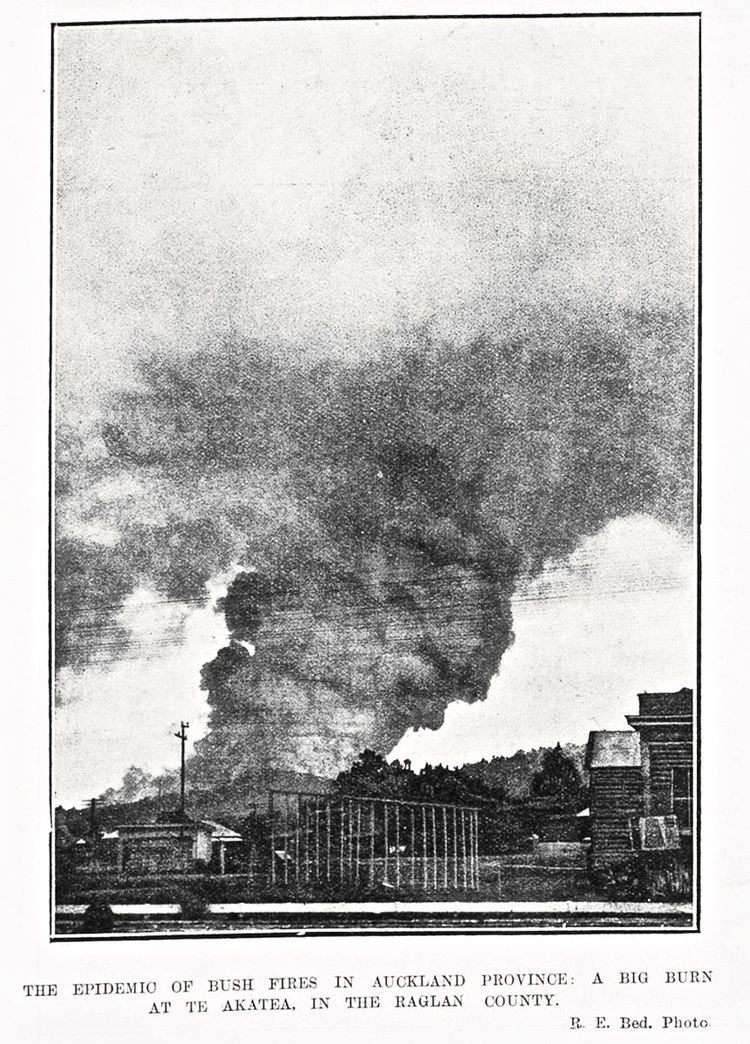 | ||
Deforestation in New Zealand has been a contentious environmental issue in the past, but now native forests, colloquially called "the bush", now have legal protection, and are not allowed to be tampered with by humans.
Contents
Pre-human forest cover
Since New Zealand was the last major landmass to be settled by humans, anthropological changes are easier to study than in countries with a longer human history. A picture of the vegetation cover has been built up through the use of archeological and fossil remains, especially pollen grains from old forests. Some of the most ancient intact forests in the world are found in New Zealand, examples being on Stewart Island and Ulva Island.
Māori settlement
Prior to Māori arrival, New Zealand was almost entirely forested, besides high alpine regions and those areas affected by volcanic activity. Māori began settling the country about 1000 years ago and by 1840, when Europeans were a small part of the total population, the forest cover had been significantly reduced from 85% down to 53%.
European settlement
When the first Europeans arrived, in 1772, there was still thick, dense forest cover. Early explorers such as Cook and Banks described the land as "immense woods, lofty trees and the finest timber" Mainly timber was used for repairs to sailing ships until the 19th Century. With the colony of New South Wales rapidly expanding, the need for timber from New Zealand began to rise. Timber exports, mainly kauri, became a major industry for New Zealand. There are records from the 1840s, stating that 50 to 100 ships could be tied to shore in Kaipara Harbour and be filled with lumber from giant floating booms that can hold 10,000 logs at a time. Besides trees as a form of lumber, many pioneers found the kauri trees valuable for the gum it produced to make varnish and linoleum mainly in the north island near Auckland. The colonist used unconventional methods to gather this gum from living trees. Stripping these trees and the ground around them resulted in the destruction of the land, rendering it unusable for agriculture (Wynn pg. 108). Without the trees to hold the soil and debris to the land, water flowed freely causing frequent flooding, which regularly occurred. As most of New Zealand was covered with thick bush, the slash and burn technique was used often to prepare land wanted for farming in forested areas. This practice was not carried out very responsibly due to the complexity of controlling a fire and in turn unintentionally resulted in large areas of land catching fire Thousands of acres were accidentally burned and destroyed.
After the Treaty of Waitangi was signed in 1840, settlers begin a rapid expansion. Deforestation continued for many uses including clearing land for farming and gardens and wood for construction. An estimated 50,000 acres (200 km2) land was also lost due to human caused forest fires within only a few days. Settlers were often granted land, such as the Homesteads, with a condition that they forfeited it if they didn't clear enough bush.
The rapid levels of deforestation can be illustrated through looking at sawmill usage. There were only six sawmills in 1843, twelve in 1847, fifteen in 1855 and ninety-three in 1868, a growth of more than fifteen times in twenty five years. Many saw-milling settlements were in turn supported by becoming railroad stops leading to more clearance and job availability. With time, the mills also became more productive. These factors helped create an exponential rate of deforestation across the country.
In 2010 31.40% of New Zealand was covered by forest. This does not include orchards or trees in parks. This figure has been slowly but steadily rising since 1998.
Recent history
By the 1970s the environmental movement started direct action to protect forests. Notable direct action campaigns were at Pureora Forest with Stephen King and the West Coast with the Native Forest Action Council and Native Forest Action. All native forest logging on public land ended in 2002 when the Labour led government upheld its election promise to stop the logging.
Forest protection
Many legal avenues now exist to protect native forests. The Resource Management Act, a major Act of Parliament that was passed in 1991, affords any natural environment a level of legal protection through the resource consent process. The logging of native trees is governed by a permit system administered by the Ministry for Primary Industries (MPI) and must be shown to be sustainable.
MPI also formulates policy on national and international illegal logging.
In 2014 special legislation was passed to allow extraction of large numbers of rimu trees which were toppled in a storm in the South Island. In early periods rimu was the timber widely used in construction. After 1950 it was replaced with treated exotic pinus radiata but small amounts were milled for furniture into the 1990s. The logs will be extracted by helicopter.
